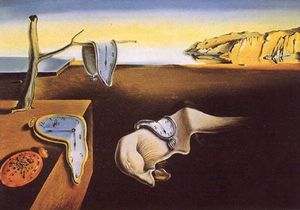Surrealism

Surrealism was a movement in literature and visual art that started in France in the second decade of the twentieth century and continued through the inter-war period. It originated from Dadaism, a movement that began during the First World War that created anti-art and negated reasoning. Surrealism took a different path from its precursor, using the new "'positive' ideas which were to implement the purely negative and destructive outlook of Dadaism."[1]
The creation of the term ‘surrealism’ is credited to Guillaume Apollinaire in 1917,[2] but ‘surrealism’ was defined by André Breton, a former Dadaist, in his Manifesto of Surrealism in 1924.[3] He defined this new movement as: “Psychic automatism in its pure state, by which one proposes to express -- verbally, by means of the written word, or in any other manner -- the actual functioning of thought. Dictated by the thought, in the absence of any control exercised by reason, exempt from any aesthetic or moral concern.”
Surrealism was based on a belief that the world of the unconscious mind, where dreams and fantasies resided, is much better than the world of the conscious mind dictated by logic and reason. [citation needed]
Surrealism in Literature
In literature, a major participant was André Breton, who defined surrealism not as a "poetic form," but a "machine" that recorded thoughts.[4] There were no aesthetic or moral boundaries that limited writers because it was spontaneity that was important. Therefore, in pursuit of spontaneity, many writers often applied the theories of Sigmund Freud and wrote in hypnoses.[5] Other writers representing surrealism were Paul Éluard, Jean Cocteau, Guillaume Apollinaire, and Louis Aragon.
Surrealism in Visual Arts
In paintings, surrealists tried to capture the dreams and fantasies and then reproduce them in forms available to the conscious mind.[6] Thus, strange objects with abnormal shapes, colors, and proportions were very common in paintings. They combined two realities together and made a ‘super-reality’ or surrealism. Among painters of surrealism there were Joan Miró, Max Ernst, Pablo Picasso, and Salvador Dali. At his death, Pablo Picasso had created around 45,000 pieces of artwork, and in 1980 his estate was appraised to be worth $250 million though experts believe it to be worth billions.[7] Salvador Dali has two museums devoted to his work: the Dali Theatre-Museum and the Salvador Dali Museum.
References
Citations
- ↑ Samuel, R.H. (1973). "Surrealism". Cassell’s Encyclopedia of World Literature. 1. p. 537.
- ↑ Ellison, Thomas (Aug 19, 2021). "Guillaume Apollinaire: Cubist, Orphist, Surrealist". TheCollector. TheCollector. Retrieved Nov 7, 2023.
- ↑ Wolfe, Shira. "Guillaume Art Movement: Surrealism". Artland Magazine. Artland. Retrieved Nov 7, 2023.
- ↑ Samuel 1973.
- ↑ Polizzotti, Mark (April 5, 2022). "The violence and creativity of André Breton's Surrealism". Apollo the International Art Magazine. Apollo. Retrieved Nov 7, 2023.
- ↑ Cuddon, J.A. (1991). "Surrealism". A Dictionary of Literary Terms and Literary Theory (3rd ed.). p. 936.
- ↑ Esterow, Milton (March 7, 2016). "The Battle for Picasso's Multi-Billion-Dollar Empire". Vanity Fair. Vanity Fair. Retrieved Nov 7, 2023.
